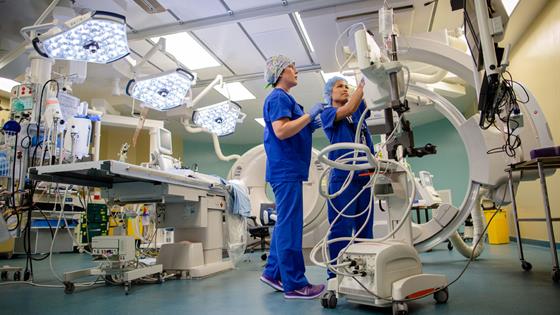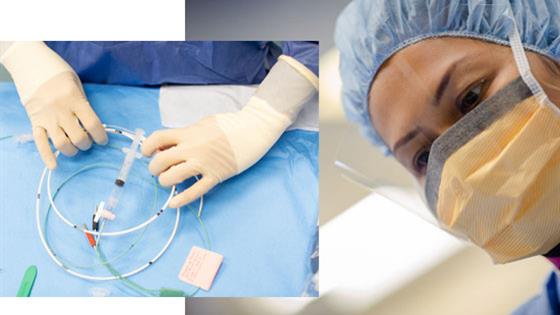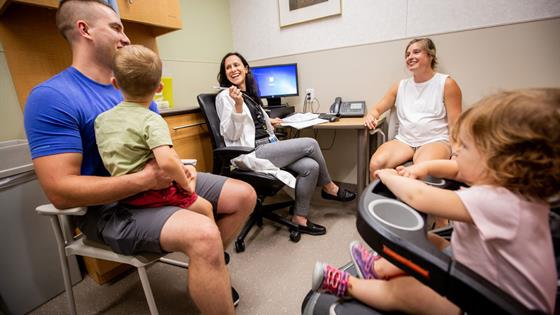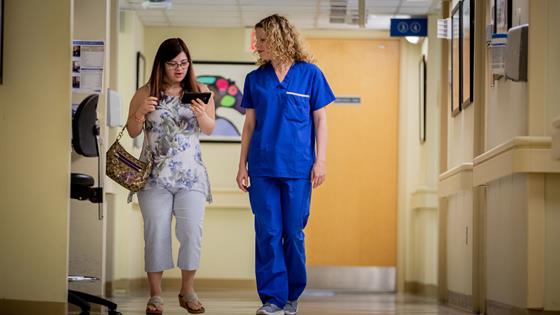STARTING THE DAY WITH A PLAN
It's 9 a.m. at the Peter Munk Cardiac Centre, and close to 25 people are crowded into a room not much bigger than most office break rooms. They wear the uniforms affiliated with the many different roles at the hospital: nursing, housekeeping, medical residents, physiotherapy and social work. Standing in one corner overseeing it all is Linda Flockhart, Clinical Director at the Peter Munk Cardiac Centre.
The hospital implemented these daily "huddles" a little over a year ago. It is a chance for all the staff working in a particular unit to come together and plan for the next 24 hours and anticipate any issues that may arise. The huddles happen throughout the centre each morning, with the manager of each unit feeding the most vital information to Ms. Flockhart on a 9:30 a.m. phone call.

Put simply, Ms. Flockhart's job is to realize the organizational goals and vision of the Peter Munk Cardiac Centre. As Clinical Director, she is tasked with managing the centre's $100-million budget, making sure her staff has the tools to do their job and working with physicians to support their initiatives. "Within reason," she says with a laugh.
Before stepping into management roles, Ms. Flockhart was a critical care nurse on the front lines of patient care. Her passion for her patients never waned – she's just able to influence patient care in a different way now. "I think I always was vocal in wanting to change the system and speak up, so this role gives me that opportunity," she says.
THE GUARDIAN ANGEL
Titi Manning-Atwell is nimbly working on patient Jason Sun's foot wounds – wiping the foot with iodine, cutting up a specialized fabric embedded with silver and shaping dressings to perfectly fit the contours of his arch. "This is the part where he's looking good and he can go away into the sunset," she says.
Ms. Manning-Atwell is a chiropodist, a medical professional who works on all aspects of foot health, from gait analysis to orthotics to treating diseases or ulcers of the foot. The majority of her patients have issues with their vascular system, the blood vessels outside the heart. When blockages occur in the vessels of the body, wounds farthest away from the heart, like the foot, may not heal as quickly because they are not supplied with enough blood. The Peter Munk Cardiac Centre Vascular Program is a one-stop shop for patients to have their condition diagnosed, be seen by a surgeon, be given a treatment plan and have their wounds healed.

A veteran in the field of chiropody for more than 42 years, Ms. Manning-Atwell gets the most difficult cases. "I tend to get them when they've been everywhere else and they're told they have to have their leg amputated and there's nothing anybody else can do," she says. "I always tell my boss, 'This is the limb salvage clinic.'" Her patients call her their guardian angel.
‘CHOOSING LIFE OVER LEG’
In a nearby, dimly-lit room, ultrasound technologist Susan Ungaro is skillfully manoeuvering a transducer probe over patient Jerry Paquet's leg. Mr. Paquet's heart beat pulses on the screen, making a "wowwow" sound with every beat and a rushing, river-like sound when Ms. Ungaro moves the probe to a vein.
Cindy Dickson, the Vascular Clinic's sole nurse, explains that Mr. Paquet is being checked into the centre's Vascular Unit today, a process that involves checking his arteries and veins for any blockages. Fortunately, he is in the clear.

Ms. Dickson joined the foot and wound clinic 12 years ago, so she has seen people from all walks of life at all stages of their disease. Treatment could mean a change of lifestyle (like quitting smoking), vascular surgery or, in rare cases, amputation. Ms. Dickson admits no one wants to have their limb removed, but this option can result in patients feeling markedly better after months of excruciating pain.
"It's like a new outlook on life. They're choosing life over leg," she says.
LEARNING THE ROPES
When a new treatment or procedure is introduced to the hospital, most people only see the final result: the patient success stories. What is often invisible are the hours of training that nurses and surgeons do to prepare.
Outside the operating room, Rebecca Collier-Doyle is already in her scrubs, wearing a cap with blue and green mandala designs. Ms. Collier-Doyle has been tasked with bringing cardiac nurses up to speed with the transcatheter aortic valve implantation, or TAVI, procedure.
TAVI allows high-risk patients to undergo valve replacement surgery without opening up their chest. A replacement valve is inserted through a small incision in the leg and guided up to the heart through a main artery. It can cut operating time from six hours down to 90 minutes and speeds up recovery time because the incisions are so small, and the patient can remain awake. That by no means makes it a simple procedure to learn, says Ms. Collier-Doyle. "It's intense in a different way [than open heart surgery]."

Today, she is training operating room nurse Haniely Pableo to set up for a TAVI procedure. To the untrained eye, many of the instruments laid out for the procedure look the same. Part of Ms. Collier-Doyle's role as a clinical support nurse is to create resources to assist the nurses in their learning. One of those resources is a binder containing each of the main pieces of equipment used in the TAVI procedure, so her nurses can see, touch and manipulate them before entering the operating room.
Learning how TAVI works and the instruments needed make up only a small part of the training. Up to four patients are wheeled in and out of the operating room in a single day. That leaves little time for cleaning and setting up between procedures, and even less time for breaks.

"It's a push," Ms. Pableo says with a sigh. Knowing what to prioritize, like having the equipment laid out and counted, is key. A sip of coffee at the beginning of a sometimes 12-hour day also helps.
SAVING LIVES TO CREATE NEW ONES
Addy Murchie is having a mid-pregnancy checkup for her third child at the Peter Munk Cardiac Centre's Adult Congenital Heart Disease Pregnancy Clinic, a program that runs in partnership with the Mount Sinai Hospital Prenatal Care Program. As Ms. Murchie discusses her health with her physician, Dr. Rachel Wald, the conversation is punctuated with laughter from her healthy son and daughter, and toys being boisterously thrown around the room. "Sometimes it's a little crazy coming in," she admits.

Ms. Murchie is a clinic success story. She was born with a coarctation of the aorta, or a narrowing of the main artery that pumps blood from the heart to the rest of the body. She says all her pregnancies have gone smoothly and she credits the clinic for that.
Ms. Murchie's husband, Nick, notes that although they live in Port Hope, Ont., which is over an hour from Toronto, "it's worth it for the help we get here. You never know what can happen."
BUILDING BRIDGES OF TRUST
It's nearing the end of the day, and Jessica Pereira is at the Peter Munk Cardiac Centre for a checkup. Ms. Pereira is engrossed in a music video by Selena Gomez, her favourite singer. The annual visits are sometimes tedious for Ms. Pereira, so her mother carries a smartphone with her favourite shows and music on it.
Ms. Pereira has Down syndrome and an atrioventricular septal defect, or holes in the heart. She attends the Dalglish Family 22q Clinic, a specialized clinic geared toward patients with special needs. The clinic is about trying to alleviate the anxiety patients feel coming to the hospital or undergoing multiple diagnostic and surgical procedures. Ms. Pereira is due for a pulmonary valve replacement later this year.

Distraction, like watching a favourite television show, often helps ease tensions, but the key is "building a bridge of trust," says Ms. Pereira's anesthesiologist, Dr. Jane Heggie.
Anesthesia assistant Joanne Bosche says giving patients some control back, like letting them pick which arm the blood pressure cuff goes on or getting them to hold the anesthesia mask, is also effective. But helping patients become comfortable with the surroundings takes some time and patience.
"I mean, everyone's a little afraid when they come into hospital," she says.
For Ms. Pereira's mother, Maria, it is comforting to know that her daughter is looked after by experts who care. "It's a very positive feeling when she comes," she says. "If I know she's comfortable, then I know they're treating her [well] and they're looking after her the best they can."
